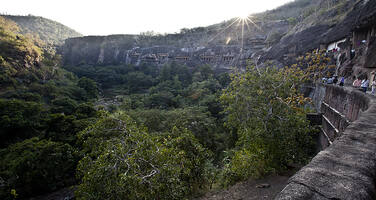Ajanta Caves
Factors affecting the property in 2002*
- Management activities
- Other Threats:
Fragile mural paintings
Factors* affecting the property identified in previous reports
- tree roots above the caves create cracks and increase water seepage into the caves, which leads to wall painting and sculpture damage and eventual structural instability;
- humidity increase within the caves caused by uncontrolled numbers of visitors which leads to fungus growth, attracting insects and eventually bats;
- inadequate security encourages vandalism and theft.
International Assistance: requests for the property until 2002
Total amount approved : 0 USD
Missions to the property until 2002**
July 2001: World Heritage Centre mission
Information presented to the Bureau of the World Heritage Committee in 2002
Previous deliberations:
25th extraordinary session of the Bureau (Chapter number III.249).
Main issues:
- Lack of microclimate control
- Progressive structural deterioration
- Absence of restoration and conservation codes adopted and implemented on a regular basis following international conservation norms
New information:
Upon the request of the national authorities, the World Heritage Centre organized a reactive monitoring mission by an international mural painting expert nominated by ICCROM between 1-9 December 2001. The mission examined the state of conservation of the mural paintings within the Ajanta and Ellora Caves and noted the following main threats facing the wall paintings:
- infiltration of rainwater into the caves;
- minor cracks on carved surfaces
- flaking of the paint layer
- infestation of bats and insects within the caves
The UNESCO expert recommended that the authorities consider:
- revising present methods for stabilizing and cleaning the wall painting surfaces;
- testing of new and alternative methods on small wall painting surfaces;
- continuous monitoring of the microclimate conditions in Ajanta Caves;
- enhancing documentation and archival material to evaluate changing conditions of the wall painting material;
- conserving further, the unique natural setting of the Ajanta and Ellora Caves by following the concept of minimal intervention with the historically established environment and giving preference to conservation solutions which involve minimal changes.
Finally, noting certain weaknesses within the institutional framework of the Archaeological Survey of India (ASI) which occasionally prevent maximum utilization of the rich capacity and experience within its various branches, the UNESCO mission recommended that co-operation be enhanced between the complementary ASI branches to enhance the long-term protection and conservation of the two sites.
At the time of the preparation of this working document, the World Heritage Centre was continuing consultations with the Indian authorities to mobilize international technical co-operation for following up on the recommendations of the UNESCO mural painting expert. Further information will be presented to the Bureau at the time of its session together with updated information on the progress made by the authorities in enhancing the co-operation between numerous national and international conservation and development activities.
Action Required
The Bureau may wish to consider further information at the time of its session and take a decision as appropriate.
Summary of the interventions
Decisions adopted by the Committee in 2002
26 COM 21B.50
Ajanta Caves / Ellora Caves (India)
The World Heritage Committee,
Takes note of the state of conservation report and the decision of the Bureau contained in document WHC-02/CONF.202/2, paragraphs XII, 84-86 and the additional information provided by the State Party at this session.
26 BUR XII.84-86
Ajanta Caves / Ellora Caves (India)
XII.84 The Bureau examined the report on the state of conservation of these two World Heritage properties presented in document WHC-02/CONF.201/11Rev and the findings and recommendations of the reactive monitoring mission undertaken by an international mural painting expert undertaken in December 2001. The Bureau noted the following threats facing both properties:
i. infiltration of rainwater into the caves;
ii. minor cracks on carved surfaces;
iii. flaking of the paint layer;
iv. infestation of bats and insects within the caves.
XII.85 The Bureau expressed its appreciation to the authorities of India for their co-operation in the organization of the reactive monitoring mission to the properties. The Bureau urged the authorities to consider the mission’s detailed recommendations concerning the conservation, management, and presentation of the properties, by
- revising present methods for stabilizing and cleaning the wall-painting surfaces;
- testing of new and alternative methods on small wall-painting surfaces;
- undertaking continuous monitoring of the microclimate conditions in Ajanta Caves;
- enhancing documentation and archival material to evaluate changing conditions of the wall-painting material;
- conserving further, the unique natural setting of the Ajanta and Ellora Caves by following the concept of minimal intervention with the historically established environment and giving preference to conservation solutions which involve minimal changes;
- enhancing co-operation between the complementary ASI branches to enhance the long-term protection and conservation of the two sites.
XII.86 Finally, the Bureau requested the World Heritage Centre to continue assisting the authorities of India to mobilize international technical assistance to enhance co-operation between numerous national and international conservation and development activities.
Documents examined by the Committee
26COM (2002)Exports
* :
The threats indicated are listed in alphabetical order; their order does not constitute a classification according to the importance of their impact on the property.
Furthermore, they are presented irrespective of the type of threat faced by the property, i.e. with specific and proven imminent danger (“ascertained danger”) or with threats which could have deleterious effects on the property’s Outstanding Universal Value (“potential danger”).
** : All mission reports are not always available electronically.


